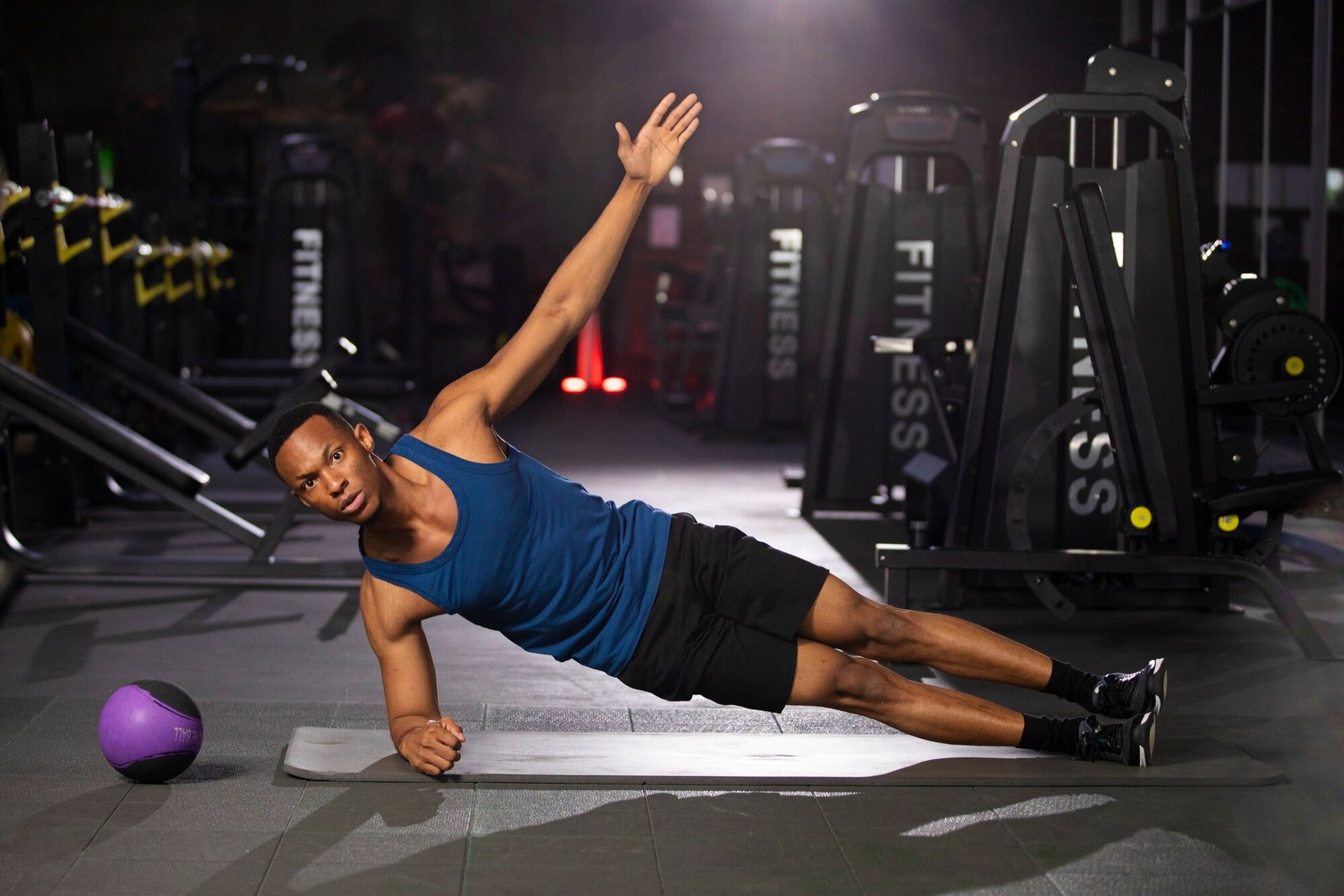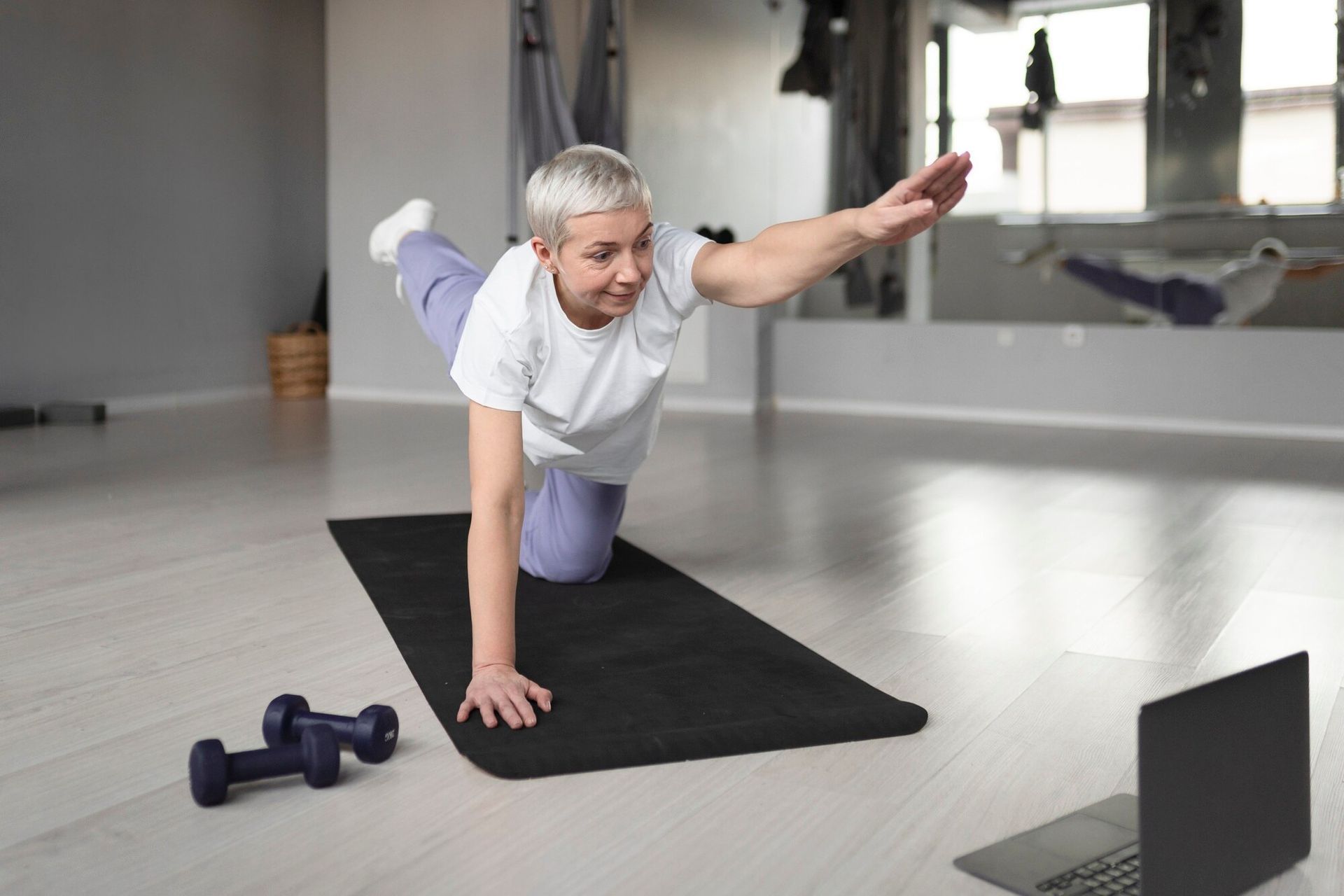Search

Getting back to the gym after an injury can be a challenging but important journey. Whether you’ve experienced a minor sprain or a more severe injury, returning to your workout routine requires patience, caution, and a smart approach to prevent re-injury and promote healing. Here’s a comprehensive guide on how to safely resume your gym activities after an injury: Consult Your Healthcare Provider Before resuming any physical activity, it’s crucial to consult your healthcare provider or a physical therapist. They can assess your injury, provide personalized recommendations, and guide you on when and how to reintroduce exercises. Following their advice is essential to avoid aggravating the injury. Start Slowly Regardless of your fitness level before the injury, starting slowly and gradually increasing your workouts’ intensity and duration is important. Begin with gentle exercises and low-impact activities that target the affected area, focusing on improving your range of motion and flexibility. Starting slowly doesn’t just mean physically. You should also take it slowly to let your mental health recover, particularly if your injury was traumatic or caused by someone else. This is a lot to overcome, so you must take it slowly and ease yourself back into your gym life. Your injury caused by a car accident, home accident, medical malpractice or whatever may impact your workouts, and this can be difficult to overcome. Fortunately, there is justice out there for you in these circumstances. Consulting an experienced attorney can be helpful to get you over those hurdles. For example, if you experienced medical malpractice, a medical malpractice attorney to look over your potential emergency room negligence case can mean you have experts on your side ready to advocate for your rights and help you seek compensation. Warm-Up and Cool Down Warm-up exercises are vital to prepare your body for more intense activity, increasing muscle blood flow and reducing the risk of injury. Similarly, cooling down after your workout with stretching and relaxation exercises helps your body recover and minimizes muscle soreness. Focus on Proper Form Pay close attention to your form during exercises. Proper technique not only maximizes the effectiveness of your workout but also reduces the risk of injury. If you’re unsure about the correct form, consider working with a certified personal trainer . They can provide guidance and ensure you’re performing exercises correctly. Incorporate Rehabilitation Exercises Include specific rehabilitation exercises recommended by your healthcare provider or physical therapist. These exercises are designed to strengthen the injured area, improve stability, and enhance overall muscle support. Be consistent with these exercises to aid in your recovery. Listen to Your Body Pay attention to how your body feels during and after each workout. Stop the activity immediately if you experience pain, discomfort, or unusual sensations. Pushing through pain can worsen the injury. Instead, modify your workout or seek advice from your healthcare provider. Modify Your Routine Modify your usual workout routine to accommodate your injury. Avoid exercises that put excessive strain on the affected area. For example, if you have a knee injury, consider swimming or cycling instead of high-impact activities like running. Low-impact exercises can provide an effective workout without stressing the injured joints or muscles. Gradually Increase Intensity As your body becomes stronger and more resilient, you can start to gradually increase the intensity and duration of your workouts. Monitor your progress closely, and don’t rush the process. Incrementally challenge yourself while staying within your comfort zone. Include Strength Training Incorporate strength training exercises to rebuild muscle strength around the injured area. Use lighter weights initially and gradually increase the resistance as your strength improves. Resistance bands and bodyweight exercises can also be effective in building muscle without excessive strain. Be Patient and Persistent Recovery takes time, and setbacks might occur along the way. Be patient with yourself and acknowledge your progress, no matter how small it may seem. Stay persistent, follow your rehabilitation plan diligently, and trust the process. Consistency and determination are key to a successful recovery. Seek Professional Guidance If you’re uncertain about how to modify your workout routine or which exercises are safe for your injury, consider seeking the expertise of a physical therapist. They can create a tailored rehabilitation plan, provide hands-on guidance, and monitor your progress, ensuring a safe and effective recovery. Celebrate Achievements Celebrate your achievements and milestones, no matter how minor they may seem. Whether it’s increased flexibility, reduced pain, or improved strength, each step forward is a victory in your recovery journey. Acknowledge your efforts and stay motivated to continue your progress. Conclusion Returning to the gym after an injury requires a mindful and strategic approach. By following these guidelines, consulting healthcare professionals, and listening to your body, you can safely resume your fitness routine, rebuild your strength, and work towards your fitness goals. Remember that your well-being is a priority, so be patient, stay consistent, and trust in your body’s ability to heal and regain its strength and vitality.

In today’s digital age, personal trainers have a plethora of tools at their disposal to enhance their services and grow their business. One of the most valuable resources for any modern trainer is a well-designed fitness app tailored to their specific needs. With so many options available, selecting the best personal trainer app can be overwhelming. If you’re just starting your research, here are some key factors personal trainers should consider to make informed decisions that align with their business goals and maximize their potential for success. Define Your Needs and Goals – What’s The Best Personal Trainer App For You and Your Clients? Before diving into the world of fitness apps, it’s crucial to assess your specific requirements and objectives so you can choose they best personal trainer app for your growing business. Are you primarily focused on client management, workout creation, progress tracking, or all of the above? Understanding your needs will help you narrow down your options and prioritize features that are essential for your business growth. Research and Compare Fitness App Options Once you have a clear understanding of your needs, research the various apps available in the market. Compare their features, pricing, user interface, customer support, and reviews from other personal trainers. Look for apps that offer comprehensive solutions tailored to personal training businesses and have a track record of success in the industry. FitSW stands out for its extremely comprehensive exercise lists, which include thousands of exercises covering various fitness goals and equipment options. Additionally, VIP Coach’s intuitive interface and easy-to-copy workout programs make it a favorite among trainers looking to streamline their workflow and deliver consistent results to clients. Consider the App’s Client Experience Features The usability and intuitiveness of a personal trainer app are crucial factors that can significantly impact your productivity and client satisfaction. Choose an app with a user-friendly interface that simplifies tasks such as creating workouts, managing clients, scheduling , and tracking progress. A well-designed app should streamline your workflow and enhance the overall experience for both you and your clients. VIP Coach helps you easily share workout and nutrition programs with your clients and lets them download and use the app for free, so you can both share and track progress. Evaluate Your Fitness App’s Customization Options Each personal training business has its own distinct identity, and it’s crucial to choose an app that accommodates this diversity. Look for platforms that provide customization features, enabling you to align the app with your brand and specific training approaches. VIP Coach stands out for its robust customization options, empowering trainers to personalize everything from client interfaces to workout templates, fostering consistency and professionalism throughout client interactions. With VIP Coach, trainers can efficiently replicate successful programs for multiple clients, saving time and boosting productivity in their business endeavors. Decide Which Integration Tools You Need to Drive Your Business Are you using other tools to manage client progress like MyFitnessPal , Fitbit , Google Calendar for scheduling or Stripe for payment processing? VIP Coach seamlessly integrates with a variety of third-party tools and platforms, enhancing its functionality and versatility. Whether it’s integrating with fitness wearables for real-time data tracking or syncing with nutrition tracking apps for comprehensive meal planning, VIP Coach ensures that trainers have access to the tools they need to deliver exceptional service to their clients. Choose a Fitness App that Offers Scalability and Support VIP Coach is designed to grow with your business, offering scalability and support for trainers at every stage of their journey. With flexible pricing plans and robust customer support, VIP Coach ensures that trainers have the resources they need to succeed. Regular updates and enhancements keep the app aligned with industry trends and evolving client needs, ensuring that trainers can stay ahead of the curve. Finding the best personal trainer app to manage your clients and grow your business is crucial. VIP Coach is the ultimate solution for personal trainers looking to elevate their business and deliver outstanding results to their clients. With its comprehensive exercise lists, easy-to-copy workout programs, intuitive progress tracking, and comprehensive nutrition programs, VIP Coach provides trainers with the tools they need to succeed in today’s competitive fitness industry. By choosing VIP Coach, trainers can streamline their operations, enhance client satisfaction, and achieve their business goals with confidence.

Gut health is vital for overall well-being and fitness performance, and personal trainers play a crucial role in optimizing both. Emerging evidence suggests that incorporating fermented foods into diets can be an effective and accessible way to support gut health. Trainers can leverage the benefits of these foods to enhance their clients’ overall health and performance, complementing their exercise routines for better fitness outcomes. Here’s some more information to help you decide if probiotics and fermented foods are the right addition to your client’s nutrition plans. Understanding Gut Health: The gut microbiome refers to a diverse collection of microorganisms living in our digestive tract. These tiny organisms are essential for maintaining overall health. Research indicates that a well-balanced gut microbiome is associated with improved digestion, a stronger immune system, and even better mental well-being. For passionate fitness enthusiasts, research suggests that a healthy gut is particularly crucial for peak performance. It affects how effectively our bodies absorb nutrients, regulates our energy levels during exercise, and facilitates post-workout recovery. As a personal trainer, understanding the connection between gut health and fitness can be vital for helping your clients maximize physical performance and achieve their fitness goals. Probiotics: Nature’s Gut Guardians: Probiotics, commonly found in fermented foods and dietary supplements, are live microorganisms that confer health benefits when consumed in adequate amounts. Numerous studies have demonstrated the positive effects of probiotics on gut health, including enhanced digestion, reduced inflammation, and strengthened immunity. For athletes, incorporating probiotic-rich foods like yogurt, kefir, and tempeh into their diets can support digestive health and bolster overall performance. Fermented Foods: Fueling Gut Health Naturally: Fermented foods undergo a natural process of fermentation, during which beneficial bacteria break down carbohydrates and produce compounds like probiotics, vitamins, and enzymes. Consuming fermented foods such as sauerkraut, kimchi, and kombucha can introduce a diverse array of beneficial microbes into the gut, promoting microbial diversity and gut health. Research indicates that regular consumption of fermented foods is associated with improved digestion, immune function, and exercise recovery. Impact on Fitness Performance: The influence of gut health on fitness performance extends beyond digestion. Studies have suggested that gut microbes may influence energy metabolism, nutrient absorption, and inflammation levels, all of which can impact athletic performance. Furthermore, a healthy gut microbiome has been linked to improved mood, mental clarity, and stress resilience, factors that are crucial for consistent training and optimal performance. Scientific Research: Recent scientific studies have provided valuable insights into the connection between gut health and fitness. For example, a study published in the Journal of Strength and Conditioning Research found that athletes with a more diverse gut microbiome exhibited better exercise performance and recovery. Another study published in the British Journal of Nutrition showed that probiotic supplementation improved markers of immune function in athletes, potentially reducing the risk of infections during intense training periods. Additionally, research published in the International Journal of Sport Nutrition and Exercise Metabolism highlighted the role of fermented foods in enhancing gut health and promoting overall well-being in athletes. Personalized Nutrition Strategies: As personal trainers, understanding the nuanced relationship between gut health and fitness allows us to develop personalized nutrition strategies for our clients. By assessing individual gut health status and dietary habits, trainers can tailor nutrition plans to optimize gut health and support fitness goals. Integrating probiotic-rich foods, fermented foods, and dietary fiber into clients’ diets can enhance gut microbial diversity and promote overall well-being. Additionally, emphasizing hydration and whole, nutrient-dense foods can further support gut health and optimize athletic performance. As a personal trainer, you can play an indispensable role in guiding clients toward their fitness objectives and fostering healthy lifestyles. Beyond simply prescribing exercises, trainers serve as mentors and allies, offering personalized strategies to address diverse needs and preferences. Whether it’s fine-tuning protein intake, meticulously tracking macros , or integrating fermented foods and probiotics into dietary plans, trainers recognize the intricate connection between gut health and overall well-being. By forging strong client-trainer partnerships, trainers can delve deeper into understanding individual goals, challenges, and aspirations. Through ongoing support and encouragement, trainers empower clients to embrace sustainable changes that not only optimize gut health and enhance physical performance but also cultivate lasting habits for a lifetime of wellness. By championing holistic approaches to nutrition and fitness, trainers instil confidence and resilience in their clients, guiding them towards a path of empowerment, vitality, and fulfilment on their transformative journey.

Are you a personal trainer looking to boost your income while helping fellow fitness professionals discover a game-changing platform? Look no further than VIP Coach’s Referral Program. Designed to reward trainers for spreading the word about VIP Coach, this program offers lucrative opportunities to earn cash payouts simply by referring others to the platform. Here’s everything you need to know to start earning with VIP Coach’s Referral Program . How It Works: The VIP Coach Referral program allows you to refer other trainers to the VIP Coach platform and earn a cash payout. For every trainer that you refer to VIP Coach using your very own referral link, you will earn between 15% and 35% of their first year of subscription fees. The percentage you earn depends on the number of trainers or organizations you refer. Share More, Earn More : 1 to 4 Trainers Referred: 15% of Revenue over 1st Year 5 to 24 Trainers Referred: 20% of Revenue over 1st Year 25 to 99 Trainers Referred: 25% of Revenue over 1st Year 100 to 499 Trainers Referred: 30% of Revenue over 1st Year 500+ Trainers Referred: 35% of Revenue over 1st Year Example Payout: Let’s say you refer 10 trainers to VIP Coach, and they sign up for the $29/month Trainer 15 plan. Your payout would look like this: First 4 Trainers (15%): $208.80 Next 6 Trainers (20%): $417.60 Total Payout: $626.40 Choose How You Earn: Payouts can be made directly to you, applied to your subscription, or applied to a custom app of your choice – whichever you prefer. You can receive your payouts within 60 days of your referral paying their subscription payment. Your referrals will be tracked right on your Refer and Earn page for you to see. Start Earning Today! Ready to start earning with VIP Coach’s Referral Program? Simply click on the “Account” tab on the top, left side of the desktop version of the app. Click “Refer & Earn” then copy your unique referral link, and share it with your fellow trainers. Whether you’re recommending VIP Coach to colleagues, friends, or followers on social media, every referral brings you one step closer to unlocking additional income while helping others discover the benefits of VIP Coach. Join the Referral Program today and turn your passion for fitness into a lucrative opportunity!

As fitness trainers working with older clients, it’s crucial to understand the importance of hip hinge exercises in promoting strength, stability, and overall mobility. Hip hinge exercises not only help seniors maintain functional movement patterns but also play a vital role in preventing injuries and improving quality of life. In this comprehensive guide, we’ll explore the benefits of hip hinge exercises for seniors, suggest complementary exercises, and discuss when to avoid certain movements. Why Hip Hinge Exercises for Seniors Are Essential: Hip hinge exercises are fundamental movements that involve bending at the hips while maintaining a neutral spine. These exercises primarily target the muscles of the posterior chain, including the glutes, hamstrings, and lower back. For seniors, maintaining strength and mobility in these muscle groups is crucial for performing daily activities independently and reducing the risk of falls. One of the key benefits of hip hinge exercises for seniors is improved strength. By targeting the muscles of the posterior chain , these exercises help seniors maintain balance and stability, reducing the risk of falls and improving overall strength. Additionally, hip hinge exercises promote stability by strengthening the core muscles and improving balance, which can help seniors maintain proper posture and alignment during everyday activities. Complementary Exercises to Enhance Hip Hinge Strength: While hip hinge exercises are essential for ageing Baby Boomers, incorporating complementary exercises can further enhance strength, stability, and mobility. Here are some exercises to consider adding to seniors’ workout routines: Deadlifts: Deadlifts are a classic hip hinge exercise that targets the posterior chain muscles. Start with light weights or resistance bands and focus on maintaining proper form and alignment throughout the movement. Glute Bridges: Glute bridges are an excellent exercise for activating the glutes and hamstrings while also improving core stability. Encourage seniors to engage their glutes and lift their hips towards the ceiling, focusing on a controlled movement. Romanian Deadlifts: Romanian deadlifts are a variation of the traditional deadlift that focuses on eccentric loading of the hamstrings. This exercise can help seniors improve hamstring flexibility and strength while also targeting the lower back muscles. Kettlebell Swings: Kettlebell swings are a dynamic hip hinge exercise that targets the entire posterior chain. Start with lighter kettlebells and focus on generating power from the hips while maintaining proper form. Here are 11 Hip Hinge Exercises you need to master. When Should Seniors Avoid Hip Hinge Exercises? While hip hinge exercises are generally safe and effective for seniors, there are certain situations where it may be necessary to avoid or modify certain movements. Here are some instances when caution should be taken: Severe Joint Pain: If a senior experiences severe joint pain or discomfort during hip hinge exercises, it’s essential to assess the cause of the pain and modify the exercise accordingly. This may involve reducing the range of motion or using lighter resistance. Recent Injury or Surgery: Seniors who have recently undergone hip or lower back surgery or are recovering from a significant injury should consult with their healthcare provider before performing hip hinge exercises. In some cases, it may be necessary to avoid certain movements until the individual has fully recovered. Osteoporosis or Osteoarthritis: Seniors with osteoporosis or osteoarthritis may need to modify hip hinge exercises to avoid exacerbating joint pain or risking fractures. Focus on low-impact variations and incorporate exercises that strengthen the surrounding muscles without placing excessive stress on the joints. Incorporating hip hinge exercises into seniors’ workout routines can have significant benefits for strength, stability, and overall mobility. By prioritizing proper form, gradually increasing intensity, and incorporating complementary exercises, fitness trainers can help seniors maintain functional movement patterns and enjoy a higher quality of life as they age. How VIP Coach App Can Help: VIP Coach is a comprehensive fitness management platform that empowers trainers to create personalized workout programs tailored to their clients’ needs, including seniors. With VIP Coach, trainers can easily design custom programs that focus on hip hinge exercises and complementary movements to improve strength and stability in older adults. VIP Coach also offers progress tracking, an extensive exercise library, and communication tools to support trainers in working with their senior clients effectively.




